Contents : AR6 – Overview · AR6 – Causes · AR6 – Impacts · AR6 – We aren’t doing enough · AR6 – Responses to climate change · NYT Opinion – The Climate Solution That’s Horrible for the Climate ·
Synthesis Report of the IPCC Sixth Assessment Report (AR6)
IPCC, 2023: Climate Change 2023: Synthesis Report. A Report of the Intergovernmental Panel on Climate Change. Contribution of Working Groups I, II and III to the Sixth Assessment Report of the Intergovernmental Panel on Climate Change [Core Writing Team, H. Lee and J. Romero (eds.)]. IPCC, Geneva, Switzerland, (in press)
The Sixth Assessment Report (AR6) of the Intergovernmental Panel on Climate Change (IPCC) is a substantial feat of collaborative research and analysis. It was written by 234 experts from 64 countries, it has been ratified by all 196 United Nations Members. Over 85 fairly dense pages, the report synthesizes the findings of three prior IPCC papers (Climate Change 2021: The Physical Science Basis, Climate Change 2022: Impacts, Adaptation and Vulnerability, and Climate Change 2022: Mitigation of Climate Change).
Published in March of 2023, the Synthesis Report reflects humanity’s best current understanding of the state of climate change science. The last assessment report (AR5) was published in 2014 and was the principal document that representatives at the Paris Climate Summate utilized to negotiate the historic Paris Agreement. There is good reason to suspect that the AR6 may end up being equally impactful. Given the significance of the AR6 synthesis report, I dug deeply into it to answer my content knowledge question and understand the current state of climate science. It is probably the most central part of my content resource collection, and as such I have divided my summary and analysis of the paper into four parts below .
Causes of Climate Change
The AR6 is unambiguous about the fact that Global Warming is happening and it is caused by human actions. For context, each statement of fact in the AR6 is followed by a statement of confidence such as very low likelihood, low likelihood, medium likelihood, high likelihood, very high likelihood and virtually certain. The IPCC defines statements of confidence in terms of probability of the outcome being true, so for example a statement with the addendum of very high likelihood is defined as having a probability of being true between 90%-100%. The only statement that I noticed expresses essentially complete confidence is the following one from the beginning of the current status and trends section of the report, stating,”Human activities, principally through emissions of greenhouse gases, have unequivocally caused global warming, with global surface temperature reaching 1.1°C above 1850-1900 in 2011-2020.” (pg. 6). The prior statement’s intention is to put to rest any serious debate that global warming is human caused. Below are figures from the AR6 employed to illustrate the link between human actions and global warming.
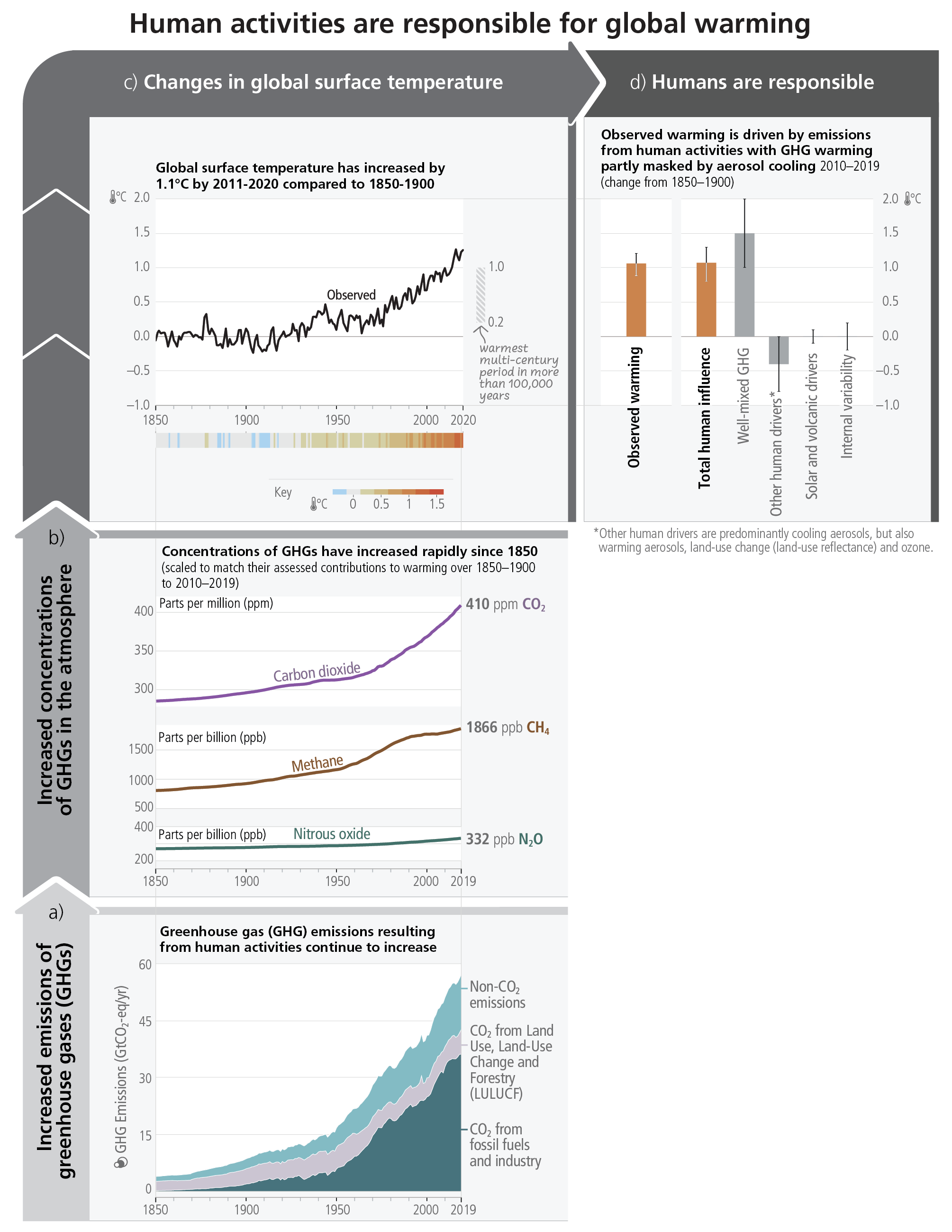
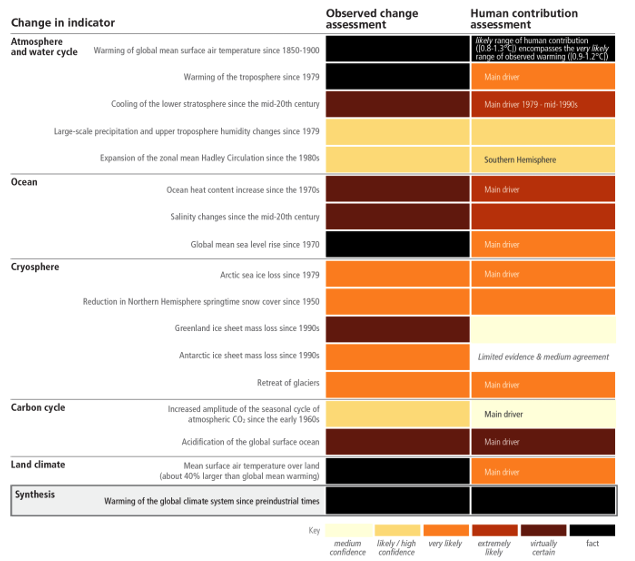
I view the AR6’s stance on the reality and cause of global warming as an anchoring point for my research question. It implies that mitigation efforts for climate change must be human directed just like the causes are. One can take a hopeful view on the fact that humans have induced global warming: if humans have definitively cause global warming they are capable of reversing it with the right amount of willpower. That perspective is the driving force behind my research.
The Impact of Global Warming
The AR6 differs from the AR5 because it states with much higher confidence that the earth is experiencing worse disasters at higher frequencies as a result of anthropogenic global warming . The report attributes increase in marine and terrestrial heatwaves, heavy precipitation events, droughts, sea level rise, flooding and tropical cyclones to anthropogenic global warming . In addition the report attributes global warming to major losses of ecosystems and biodiversity, decreasing food and water security, negative impacts on human health, infrastructure and more. The figures below reveal the extent to which such disasters are occurring as a result of climate change.
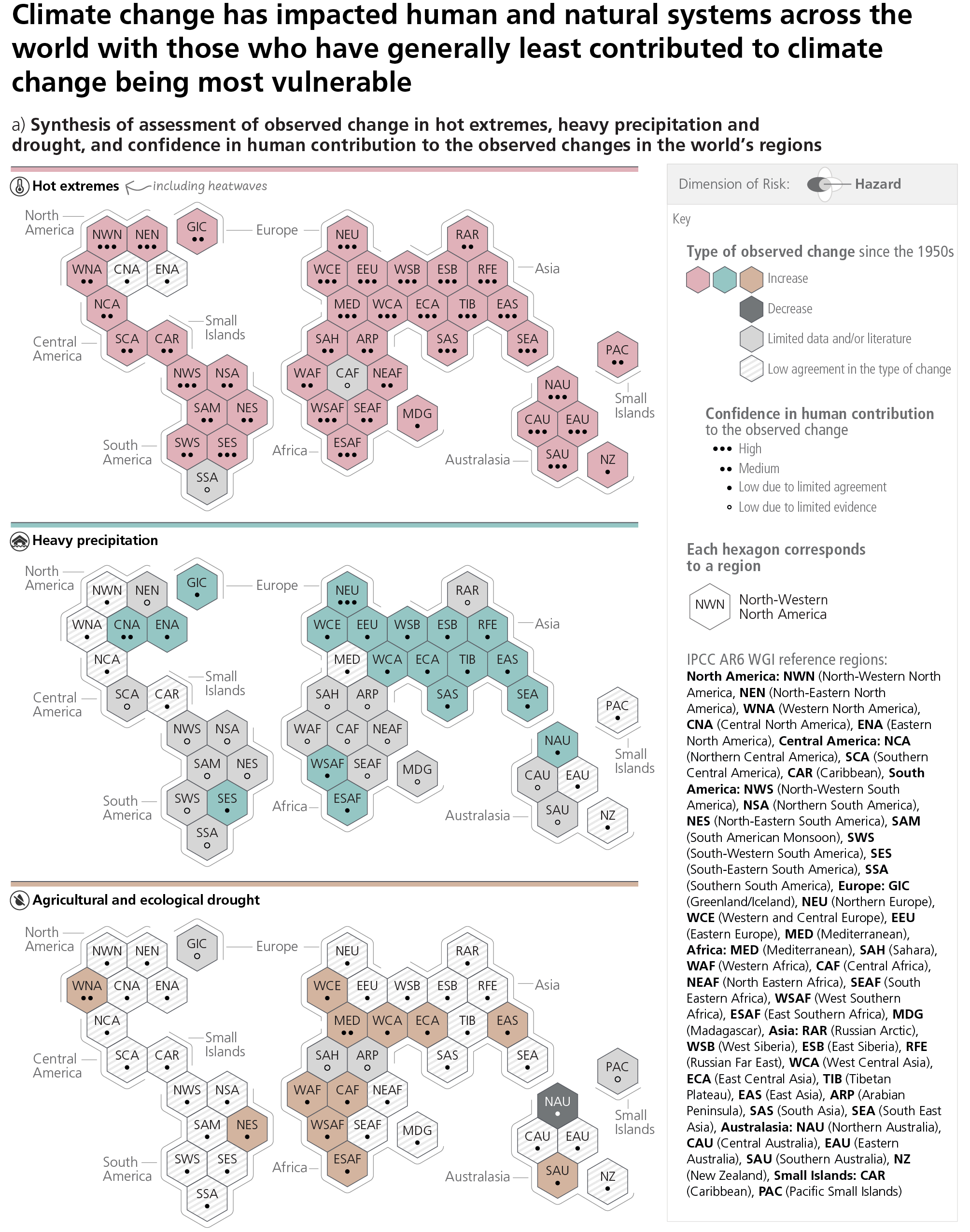
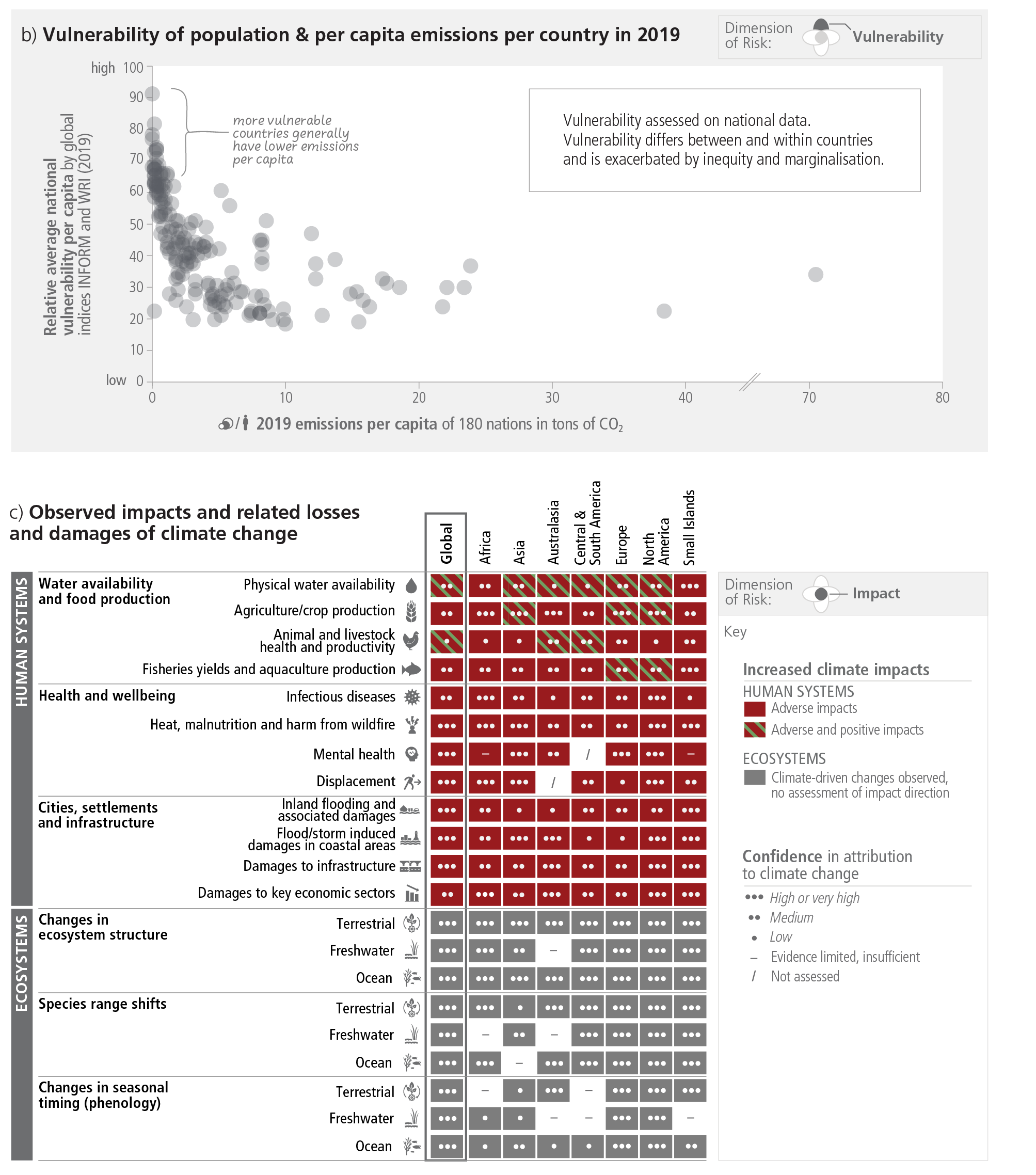
The report goes on to illustrate how the impacts of climate change will escalate depending on how much we continue to emit and therefore allow the world to warm. Impacts will worsen exponentially with every increment of increased average warming as the figures below help to illustrate.
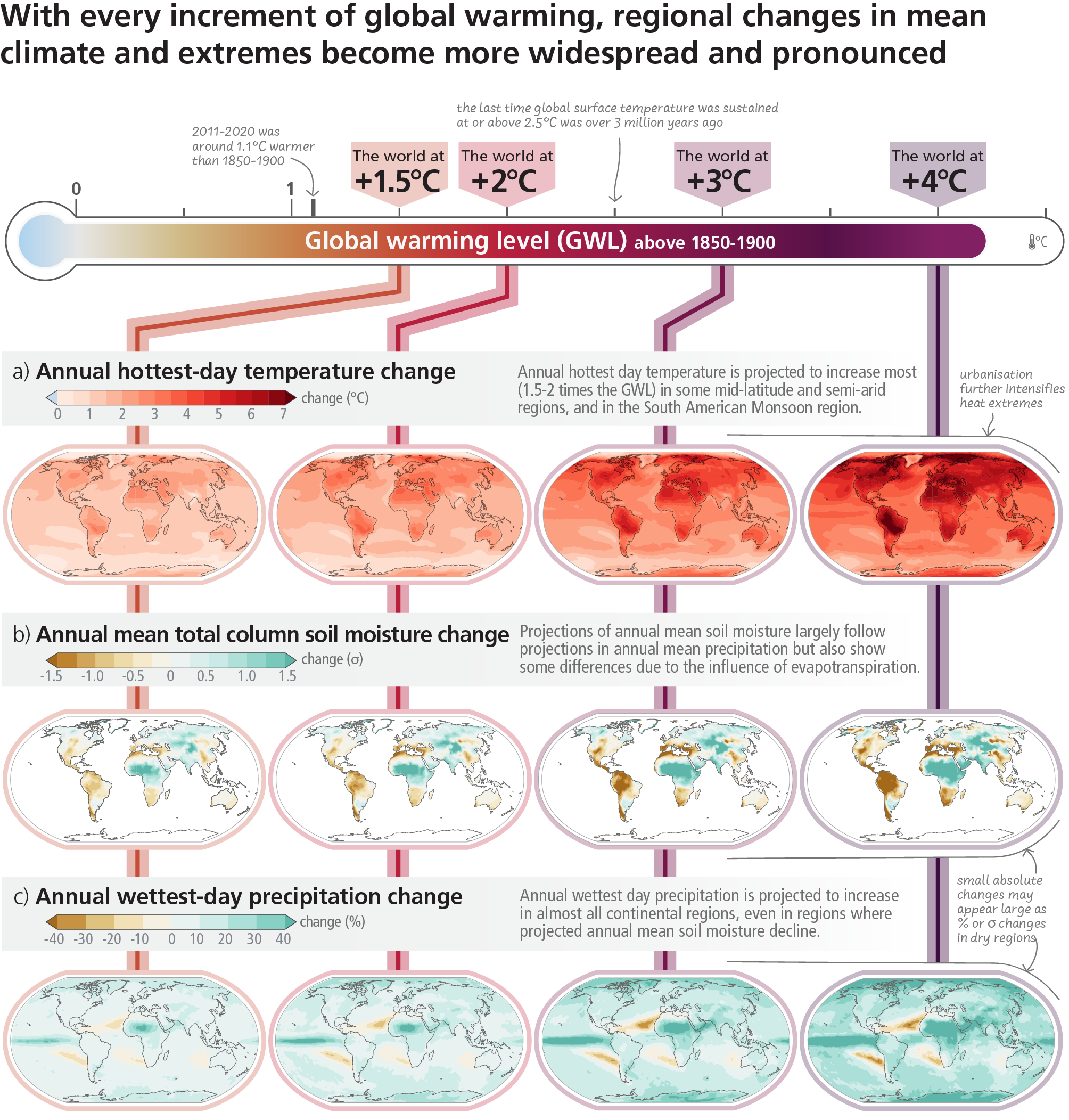
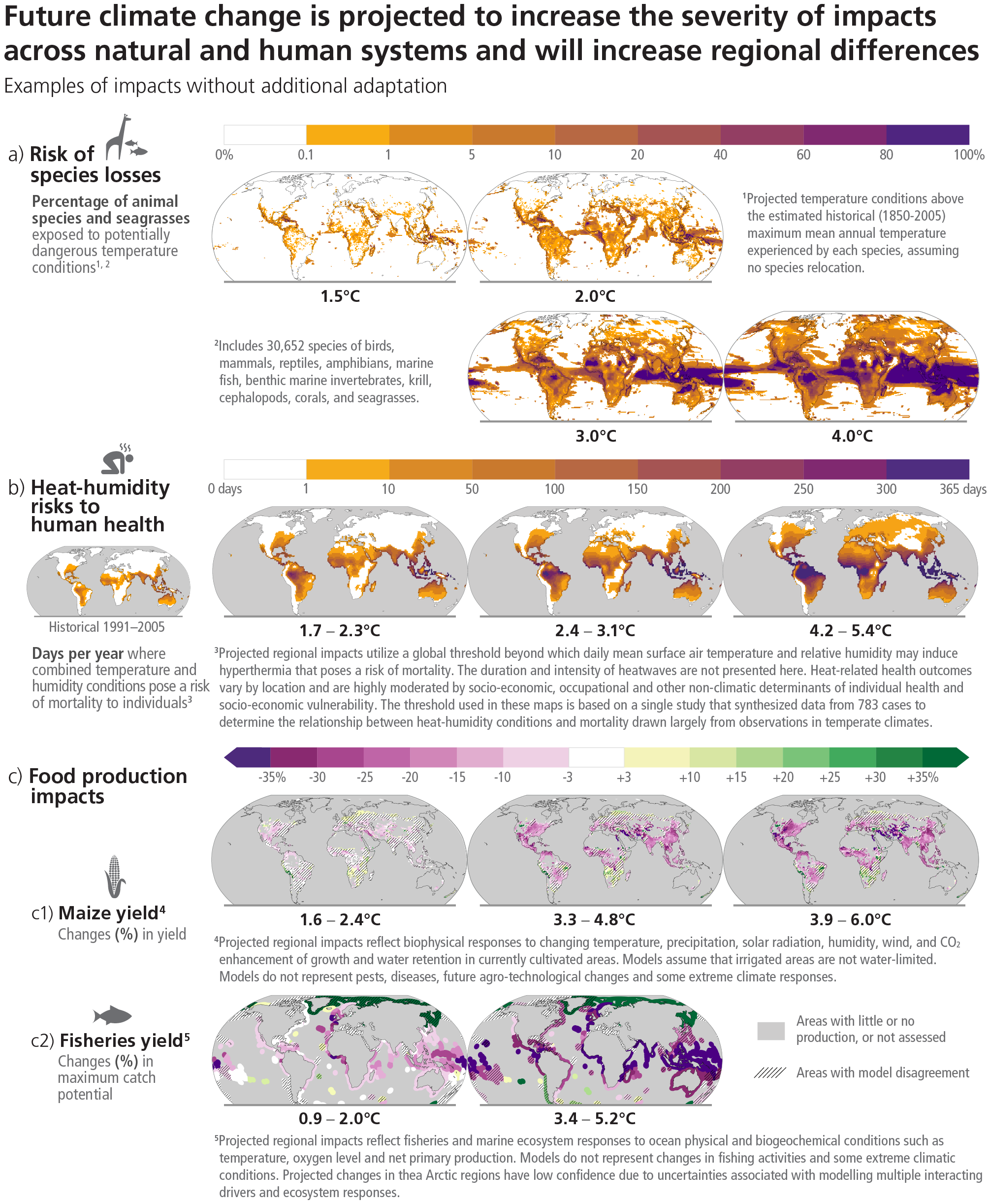
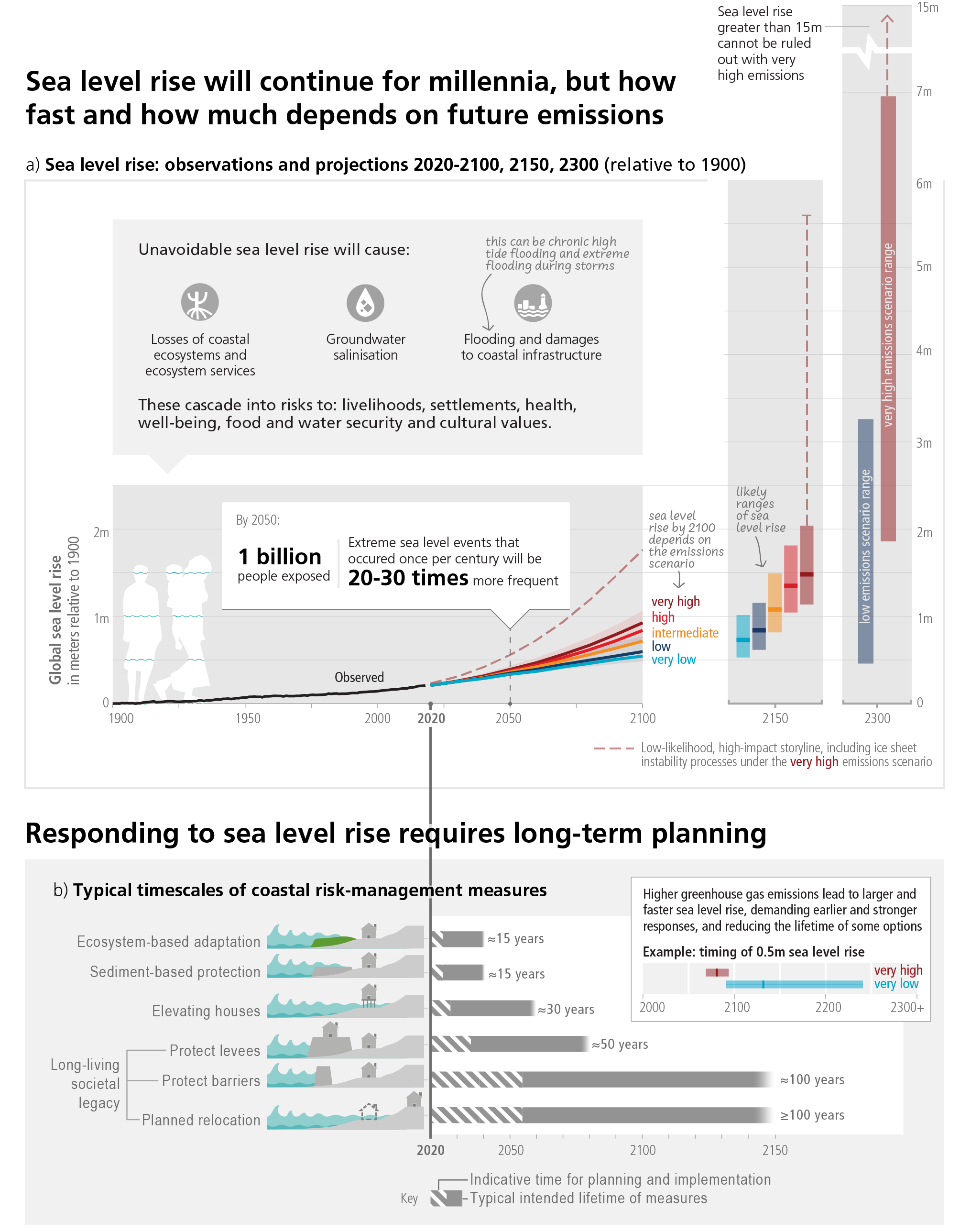
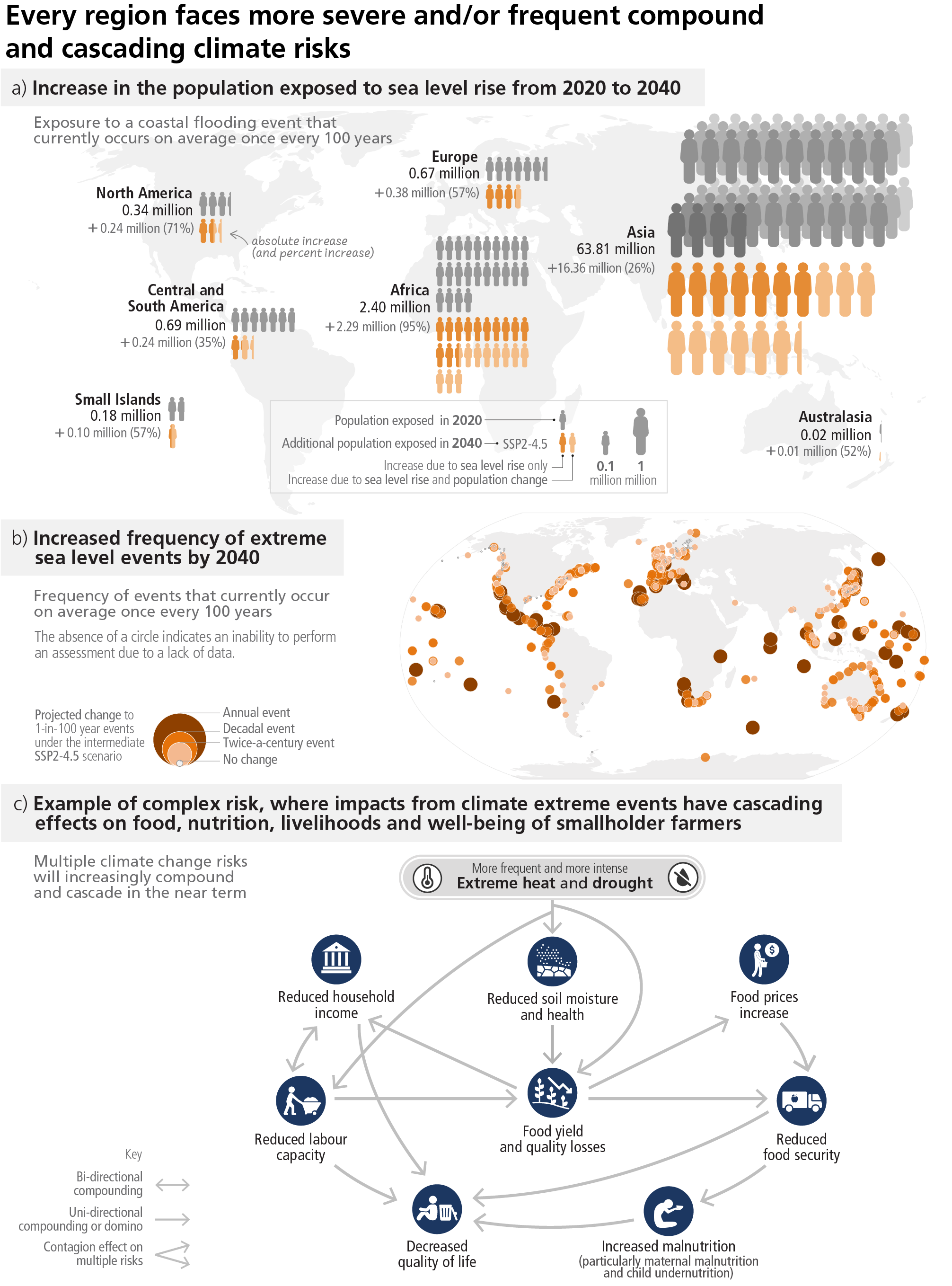
I see this aspect of the report on the present and future impact of climate change as relevant to my research question because it defines the urgency of global warming. We are already being effected by global warming and without serious mitigation strategies it will only get worse. Every tenth of a degree of warming is significant. The cost of inaction or not doing enough is therefore quite high, which validates more intensive mitigation strategies that may themselves feel otherwise burdensome. The next two aspects of the report that I analyze speak to our current actions and what we should be doing.
We are not doing enough
Another aspect of the AR6 that I found illuminating for my research question is its analysis of the so called “emissions gap”. The emissions gap is the discrepancy between the amount of greenhouse gases that we need to be reducing from our emissions to reach the 1.5°-2° C warming goal by 2100 set by the Paris Agreement and our actual current emissions as well as the trajectory of future emissions we are expected to produce if we don’t shift course. Essentially the AR6 says that if we stay on our current trajectory we will far overshoot 2° C of warming. Even if we do implement all the policies that governments around the world have committed to but not enacted then we will likely “overshoot” 2° C by 2030 before potentially being able to reduce the temperature in the following decades. The figure below illustrates the trajectories of warming that we are likely to hit (note that NDC stands for Nationally Defined Commitments and are the plans countries have pledged to implement but which in reality are not undertaking.)
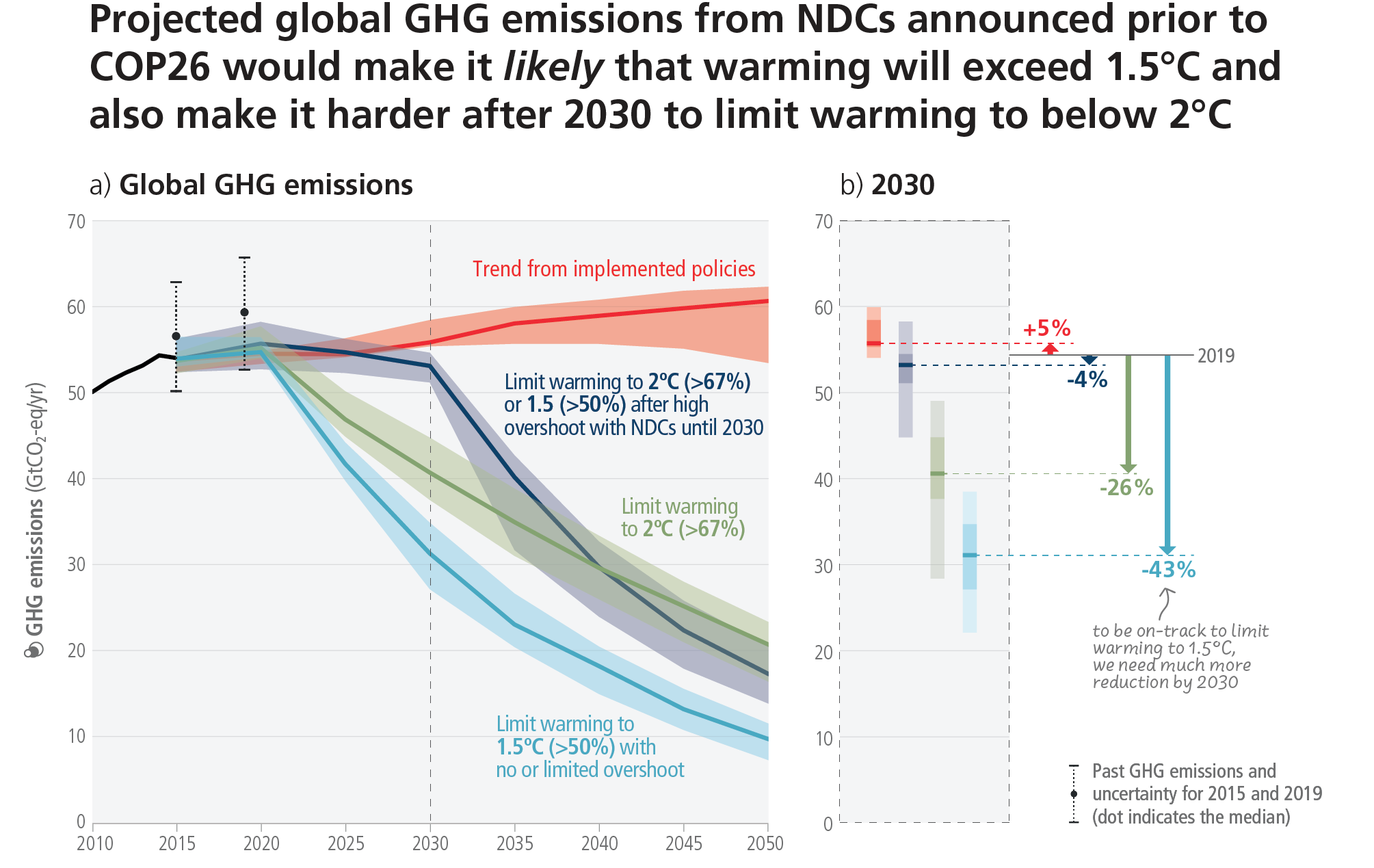
The report is essentially saying that we are on the edge of a cliff that we are about to fall off of in terms of greenhouse gas emissions. It will be possible to avert the worst consequences of warming, but not if we do not act dramatically and quickly. The reality is that to avert the worst consequences of global warming we need to do much more than we have even committed to doing, and we haven’t even been able to meet our commitments.
The next major topic of report that I will discuss is the options that we have to mitigate global warming – the crux of my research question. I felt it was important to summarize the current section first though because it provides necessary context to make sense of solution. Understanding our emissions gap leads to an implication that the solutions proposed need to be taken quite seriously and implemented rapidly despite their costs. Not doing so will, as the prior section shows, lead to disastrous outcomes.
Responses to Climate Change
One of the key points that the report makes is that the sooner that we take steps to mitigate the pace of climate the change, the more impactful our actions will be. Due to various so called “tipping points” and “feedback loops” as global warming progresses its consequences becomes exponentially worse and more expensive to mitigate.
The report also discusses the need to diversify the kinds of emission reduction strategies that we implement. There is the implication that going all in on mitigation with a single strategy would result in diminishing returns. Policies should be implemented in all economic sector. Although each economic sector has some low hanging fruit for mitigation options, only implementing the easy solutions will not reduce warming to 2° C levels alone and some higher cost options will be necessary. Similarly there are certain mitigation strategies that would work synergistically with other United Nation development goals. These solutions are not necessarily cheap, but their outcomes are win-win in that they move our world to a more equitable place while also combatting climate change. These are the types of solutions that those like Paul Hawking is a proponent of, but it seems to me that on their own they are not sufficient to reduce warming to necessary levels.
The below image captures the diverse solutions that are necessary to implement and mitigate global warming.
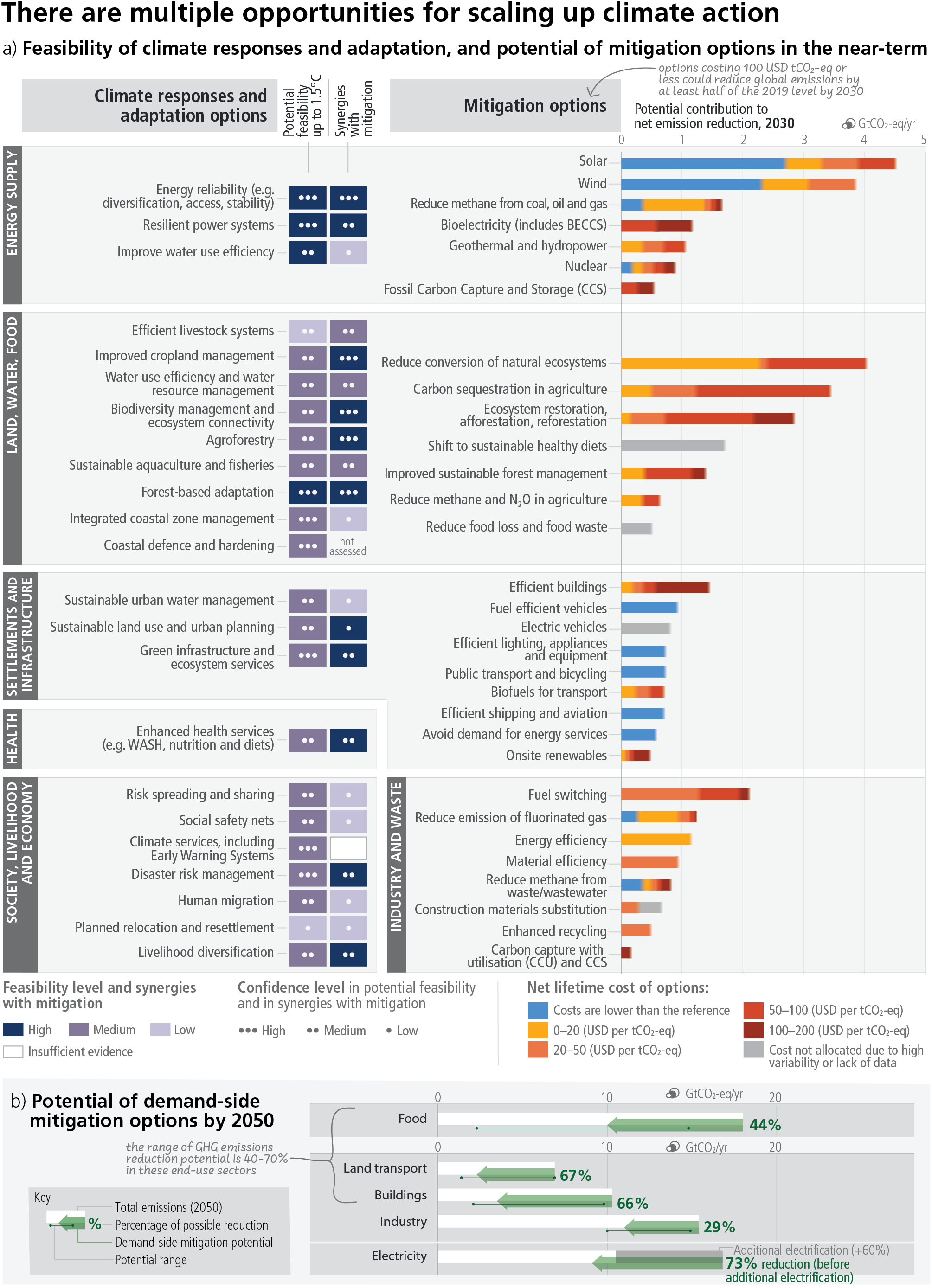
Building off the prior figure, the below image illustrates the cost tradeoff of different climate strategies. Some mitigation strategies produce equitable synergistic outcomes while others do the opposite. Regardless a diverse portfolio of climate strategies necessitates implementation of policies that will not always be win-win, although perhaps we should start implementing the most positiviely beneficial strategies first.
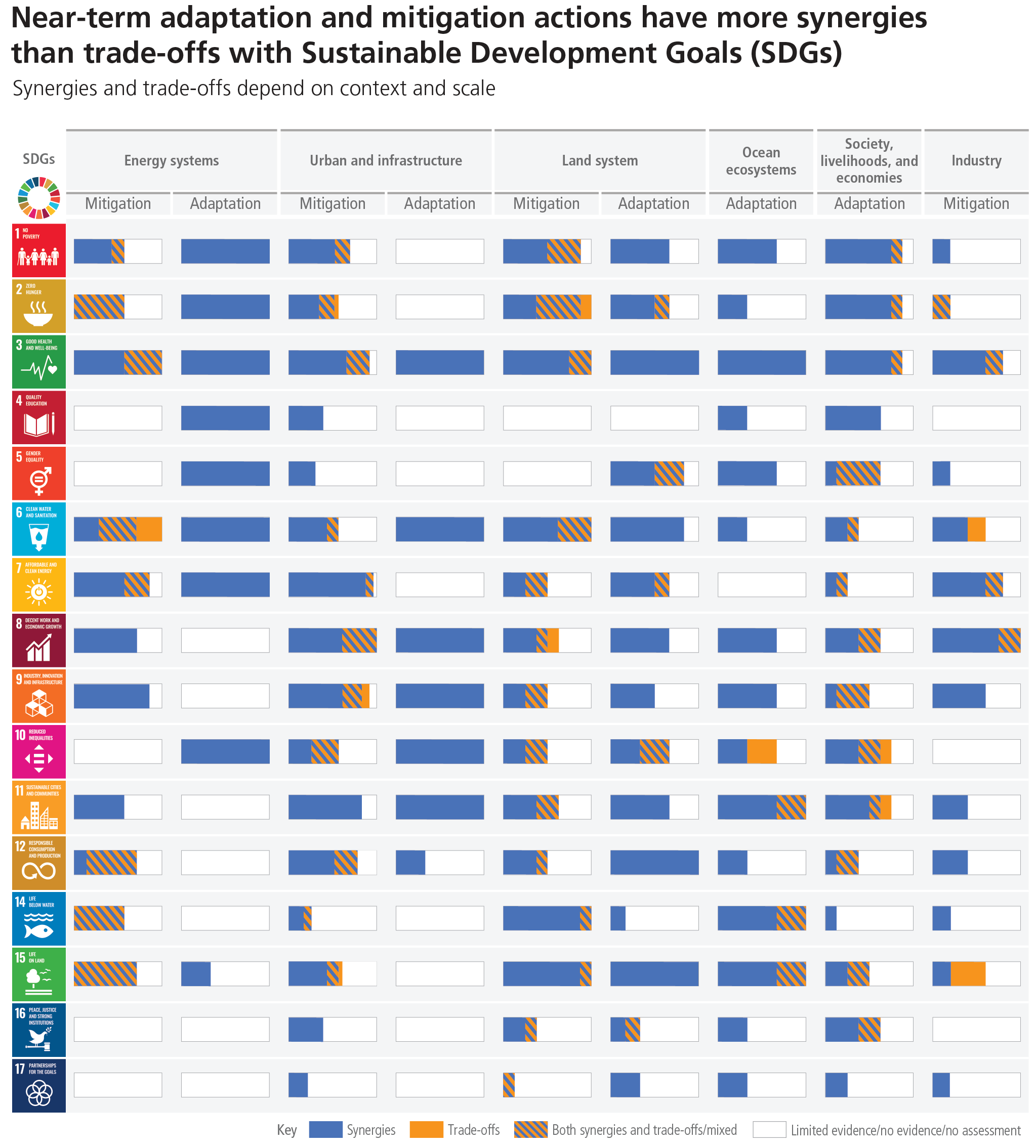
The final figure that I will share below demonstrates just how much concerted societal effort is needed to stem global warming. The graph illustrate the enormity of the financial gap between money that needs to be spent to meet global warming goals, and actual expenditures. It is a critical takeaway from this report that substantially more money needs to be invested on mitigation strategies.
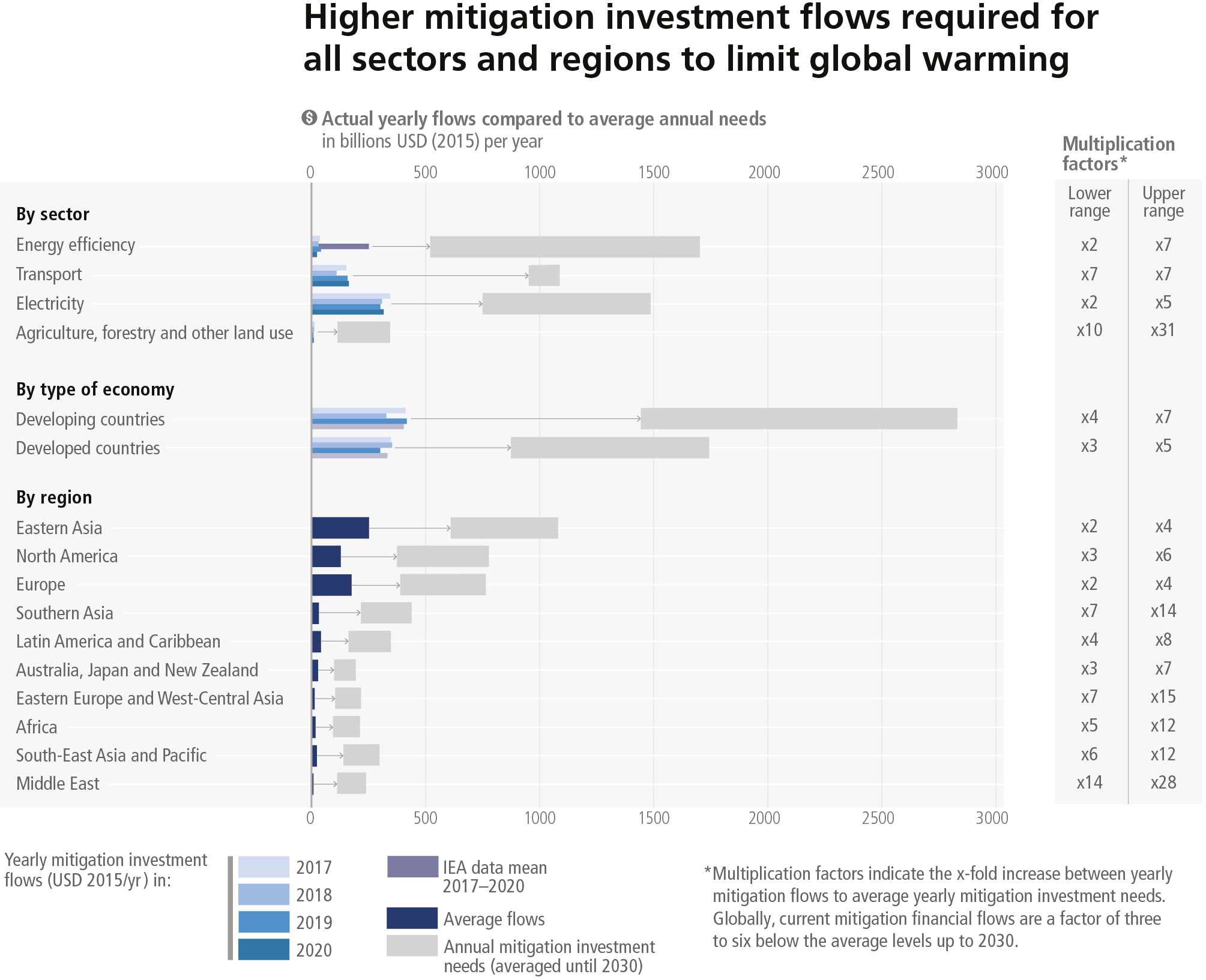
In summary, the AR6 report provided substantial headway for answering my research question by laying out in great detail the most up to date science on climate change. It defines with certainty that climate change is caused by human activity, that it has already had major consequences for our society which will continue to get worse with disastrous consequences if we don’t act quickly. I made real progress on my question with the report’s insinuation that a diversity of responses are necessary. To a certain extent it makes me think that my original question was wrongly asked. We shouldn’t perhaps be wondering which mitigation strategies get the most bang for the buck but rather how to implement as many strategies as possible as quickly as possible.
The Climate Solution That’s Horrible for the Climate
Grunwald, M. (2023, June 6). Opinion | The Climate Solution That’s Horrible for the Climate. The New York Times. https://www.nytimes.com/2023/06/06/opinion/climate-change-biofuels-corn-ethanol.html
This article highlights the inefficiency and negative environmental impact of biofuels, particularly corn ethanol and soy biodiesel, which are being promoted as renewable fuels in the United States. The author argues that biofuels require significantly more land compared to solar and wind farms to produce a relatively small amount of energy. This land usage takes away valuable space that could be used for carbon sequestration and food production. The article suggests that the Environmental Protection Agency (EPA) should update its biofuel production mandate to address these issues. However, it is unlikely to happen due to the political influence and bipartisan support for biofuels, driven by agricultural interests. The author points out that biofuels contribute to greenhouse gas emissions and deforestation, which is especially concerning considering the availability of better alternatives like electric vehicles. The piece also discusses the history of political pandering to ethanol producers in the United States, including the influence of the Iowa caucus. It concludes by urging President Biden’s administration to reconsider the Renewable Fuel Standard and promote biofuels made from non-food sources or waste products instead of relying on crops.
critique
A critique of the article could argue that it oversimplifies the complexities and potential benefits of biofuels as a renewable energy source. Here are a few points that could be raised:
- Limited scope: The article focuses primarily on corn ethanol and soy biodiesel, disregarding other types of biofuels, such as cellulosic ethanol or algae-based biodiesel, which have the potential to be more environmentally friendly and less land-intensive.
- Incomplete assessment: While the article mentions the land footprint of biofuels, it fails to acknowledge that renewable energy sources like solar and wind also require land for installation and infrastructure. A comprehensive analysis should consider the land requirements and environmental impacts of different energy sources holistically.
- Technological advancements: The article doesn’t account for the potential advancements in biofuel production technologies. Research and development efforts are ongoing to improve the efficiency and sustainability of biofuel production, which could mitigate some of the concerns raised in the article.
- Carbon neutrality: Biofuels, when produced sustainably, can be carbon-neutral or even carbon-negative, meaning they remove more carbon dioxide from the atmosphere than they emit. This aspect was not adequately addressed in the article, and the potential for biofuels to contribute to climate change mitigation should be recognized.
- Complementary role: Biofuels can play a complementary role alongside other renewable energy sources, such as solar and wind power, especially in sectors like aviation and heavy transportation where electrification is challenging. It’s important to consider a diversified energy portfolio rather than dismissing biofuels outright.
- Economic and agricultural benefits: The article does not acknowledge the economic benefits and support for rural economies that biofuel production can bring. Biofuels provide opportunities for agricultural diversification and income generation for farmers, contributing to local development.
Overall, while it is crucial to critically evaluate the environmental impact and efficiency of biofuels, it is also important to consider the potential advancements in technology, sustainability practices, and the broader context of the energy transition.
Relevance
Complicating the summative conclusion I drew from the AR6, this article suggests that a shotgun strategy of combatting climate change with as many approaches as possible might be counterproductive. It reignites an idea that originally spurred on my research, that we need to be very careful and analytical about how to spend our limited resources. Unfortunately it might be difficult to assess with confidence which mitigation strategies are not worth the investment until after substantial resources have been wasted (it is worth noting that we have been investing heavily in biofuels for many decades). This risk of investing in the wrong strategies is particularly pronounced for some of the more speculative strategies that rely on new technologies. It is worth keeping in mind that at one point biofuels were also a speculative technology.
